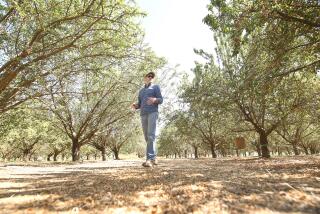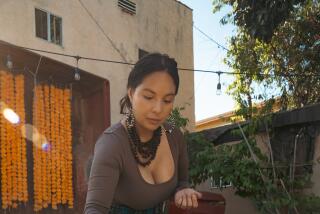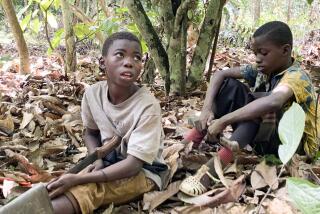Brazil’s Cocoa Blight Points to Global Spread of Farm Pests
ILHEUS, Brazil — The European foot-and-mouth epidemic offers few insights about agricultural devastation that Jose Bardaro doesn’t already have. An invisible airborne pest, a virtual organic neutron bomb, has destroyed his crops and livelihood and the entire region’s economy.
Bardaro and thousands of other cocoa growers in northeastern Brazil have stood by helplessly as a mysterious fungus called witch’s broom has cut a swath through their plantations, underscoring the alarming tendency of once-isolated pests to leapfrog regions and continents.
Only now is the devastation finally leveling off, 12 years after the fungus appeared in this corner of Bahia state. Since then, a quarter of a million farm jobs and $1 billion in annual cocoa exports have been lost--as has a way of life celebrated in the novels of Brazil’s best-known writer, Jorge Amado.
“I couldn’t sell my land if I wanted to. There is too much debt on it,” said Bardaro, 68, whose farm produces one-tenth the cocoa it did in 1992. To retrench, Bardaro has fired employees, rented out his main house, trimmed a lifestyle once marked by European and U.S. vacations and seen his wife go to work in a fitness salon.
How the fungus once confined to the Amazon conquered the former world capital of cocoa is a mystery. With little information about the fungus’ origins, conspiracy theories abound. Rival producing nations, chocolate companies, even the Brazilian government are blamed.
Whatever its origin, the Brazilian cocoa plague is an example of how agricultural pests, especially fungi, have become increasingly mobile. In recent years, an Indian wheat plague has invaded California’s Imperial Valley, an African coffee pest has ravaged Colombia and Costa Rica, and an oak tree killer of uncertain origin has spread to six California counties.
“With the greater mobility of people and trade items, it’s an accelerating process,” said Stephen Rehner, a Department of Agriculture scientist in Beltsville, Md. “We’re moving these organisms around the world, and every once in a while one will find a new susceptible host, and you get these widespread epidemics.”
Given the interconnections of the world through trade and tourism, chances are good that the pace of new agricultural epidemics will pick up, said Joseph Saunders, pest management professor at the Institute for Tropical Agricultural Research and Higher Education in Coronado, Costa Rica.
“A disease brought from one area where it is indigenous to one where it is exotic is especially dangerous because there are no biological controls or defenses,” Saunders said.
Saunders noted that 2,000 new fungus varieties are discovered every year, many of them pathogenic. Since fungi are so hard to control--as anybody with lawn mushrooms or athlete’s foot knows--potential plant diseases can quickly devastate entire regions.
The world’s second-largest cocoa producer as recently as 1985, Brazil has seen its production fall so sharply that it probably will never regain its preeminence. Last year’s harvest of 124,000 tons is one-quarter of Brazil’s 1985 record and one-tenth of leader Ivory Coast’s 1.3-million-ton output last year.
The economic devastation is palpable in this once-thriving port town now dotted with empty warehouses and crumbling mansions. Its slums are inhabited by thousands of unemployed farm workers who have left the countryside.
“The cities weren’t ready for them,” said Antonio Zugaib, economic development director for Ilheus. “The unemployed don’t consume but need housing, health services and cause crime. Many are living on biscuits. A culture that lasted two centuries is gone.”
The fungus that has wrought so much misery causes foliage on the tops of cocoa trees to shrivel and fruit to spoil. The name witch’s broom describes the desiccated treetops after the fungus has sucked them dry of moisture. Healthy cocoa fruit resemble overgrown avocados in shape and are yellow when ripe.
In pure devastation, witch’s broom could be compared with the blight that killed most of the chestnut trees in the U.S. early last century; with the plague that ravaged Caribbean banana plantations in the 1940s; and with Dutch elm disease that ruined the leafy tableau of Main Street U.S.A. in the 1970s.
All the diseases are caused by fungi, and all arrived mysteriously, taking few--if any--prisoners.
Bahia’s reversal of fortune was inconceivable as recently as the 1980s, when Ilheus was riding a 100-year wave of wealth generated by global demand for cocoa and the region’s ability to supply it.
Although cocoa had been grown throughout much of Latin America for centuries, cocoa plantations proliferated here in the late 19th century after fruit trees were found to thrive on southern Bahia’s rich soil, 80 inches of annual rainfall and forest cover.
Used mainly for chocolate flavoring and cosmetics, cocoa in whole or pressed seeds or liquid extract was soon being shipped from Ilheus to all corners of the globe. The demand gave rise to storied wealth among cocoa “colonels,” the feudal barons who ruled northern Brazil and whose lusty lives inspired Amado.
Brazil lost its lead in cocoa in the 1950s to Ivory Coast, which now supplies 45% of world demand.
By the early 1980s, Bahia had begun to feel the effects of global competition, especially from expanding farms in equatorial Africa.
As prices fell, doom knocked on Bahia’s door in 1989 when witch’s broom appeared. The fungus is now present on 98% of the state’s cocoa farms. Bardaro said infestation has been “total” on his 1,000-acre farm since 1996.
The pervasiveness of the fungus caused cocoa shipments abroad to fall to virtually zero, with domestic production now just enough to meet the nation’s needs. In 1988, Brazil’s $1 billion in cocoa exports represented 6% of the nation’s total trade.
Despite widespread rancor, there is consensus among officials, traders and even some growers that the fight against the fungus is finally showing some success. Nine varieties of fungus-resistant grafts have been made on traditional cocoa trees, such as one called Scavina developed in Trinidad. Bardaro has two such grafts on his farm.
“Cocoa production has not improved yet, but it has stopped falling,” said Luis Fernando Brandao, a cocoa trader and grower based in Salvador, the capital of Bahia state 125 miles north of Ilheus.
Brandao’s guarded optimism is borne out by market research done by ED&F; Man Holdings, a major London-based commodities trader, which predicts that countrywide production may even increase a bit this year to 126,000 tons.
It doesn’t help the growers’ cause that cocoa prices are near 50-year lows, with the world glutted by production from African and East Asian suppliers, which have stepped into the breach created by Brazil’s problems.
Nor is there any great clamoring for Brazilian cocoa among international buyers, such as Hershey Foods or Mars, once Brazil’s two biggest customers. A Hershey spokesman said the roasting and mixing of cocoa--not its country of origin--are the critical factors in its candy’s flavor.
To gather political support, the cocoa industry is trying to align itself with environmentalists campaigning to protect the Mata Atlantica, the remnants of Brazil’s primeval Atlantic Forest, one of the world’s most biologically diverse, said Wallace Setenta, director of the National Council of Cocoa Growers in nearby Itabuna.
Cocoa cultivation works to preserve the forest because of the fruit trees’ need for shade from larger, older trees. Bardaro’s plantation is covered with stately 150-foot-high jequitiba, aderno, araca and conduru trees, species that are unique to the region.
But neighboring farmers, cut off from their livelihood by the plague, are clearing forests to raise coffee or cattle. An estimated 5% of the forest that once covered the cocoa-growing region is gone, said Zugaib, the economic development director.
Bardaro is understandably jaded about the latest purported fix. But, fondling a healthy and maturing cocoa fruit that hangs shoulder-high from a grafted tree on his hilly estate, he allows himself a small portion of optimism.
Bardaro, warily checking for signs of infestation in the 8-foot-tall tree, says he has little choice. He has tried switching to flower growing and dairy farming with no success, blaming the hilly terrain and humid climate.
“I’m not convinced it will work. The resistance to the fungus could break down,” said Bardaro, a third-generation cocoa planter whose grandfather inspired a character in an Amado novel about feuding cocoa barons. “But we are giving it a chance.”
More to Read
Sign up for Essential California
The most important California stories and recommendations in your inbox every morning.
You may occasionally receive promotional content from the Los Angeles Times.










